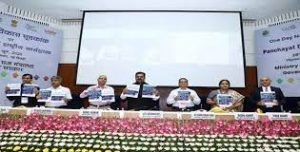Panchayat Development Index Report:

The Union Minister of State for Panchayati Raj released the Report on Panchayat Development Index (PDI) at the National Workshop on Panchayat Development Index in New Delhi.
Key Highlights of the Report on the PDI:
- The pilot project was carried out in four districts of Maharashtra, namely Pune, Sangli, Satara, and Solapur.
- The data collected from the pilot project was used to compile the report of the Panchayat Development Index Committee.
- The pilot study showed that 70% of the panchayats in the four districts of Maharashtra fall in Category C, while 27% are in Category B.
- The report highlights the need for evidence-based planning, resources must be deployed where required for overall development.
Panchayat Development Index:
- The PDI is a composite index that measures the performance of panchayats in achieving the Localization of Sustainable Development Goals (SDGs).
- It provides a holistic and evidence-based assessment of the development status of panchayats, highlighting their strengths and weaknesses.
- The PDI aims to promote the Localization of SDGs by creating awareness among panchayats and stakeholders about their importance.
- It encourages panchayats to adopt best practices and innovations to improve their performance in achieving SDGs.
- The PDI provides rankings for panchayats at different levels, including district, block, and village, based on their overall scores.
- Panchayats are categorized into four grades: D (scores under 40%), C (40-60%), B (60-75%), A (75-90%), and A+ (above 90%).
- The PDI considers nine themes, including poverty-free and enhanced livelihood, healthy village, child-friendly village, water-sufficient village, clean and green village, self-sufficient infrastructure, socially just and secured villages, good governance, and women-friendly village.




